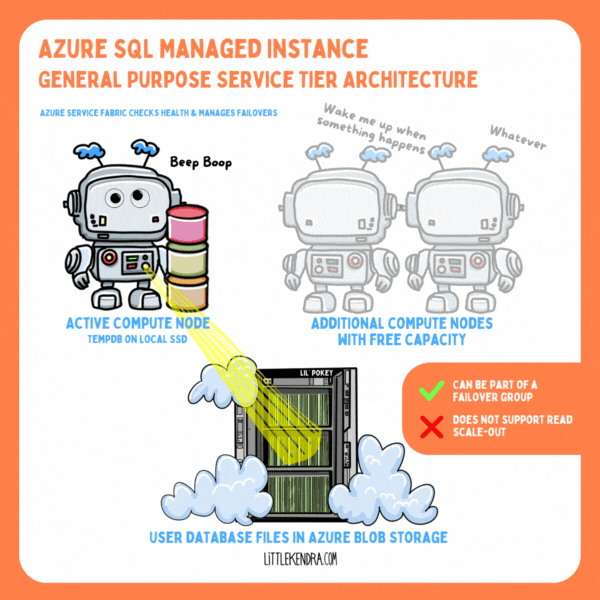How to Filter RPC_Completed Events in Extended Events: SQL Server Guide
The rpc_completed event in Extended Events is useful when troubleshooting SQL Server performance. It captures detailed information about Remote …
Whether or not you use Azure SQL Managed Instance, you will likely be asked for an opinion on it eventually if you’re a SQL Server person.
While the architecture is documented, it can be a bit of a long read and some of the gotchas are spread out over different pages – so I’m drawing up the architecture of each service tier along with notable implications for the design on performance and cost. Here’s the scoop on General Purpose.
Here’s the basic architecture for the General Purpose Service Tier. It’s basically a failover cluster style design with one active virtual compute node and shared storage.

The big old gotcha is that the shared storage is Azure Blob Storage, which is not renowned for its speed. There is also a maximum number of IOPs based on data file size which maxes out at a throughput of 250 MiB/s– your IO will be throttled if it exceeds this.
Because of the pokey storage, the docs for General Purpose notes regarding failovers that:
a heavy workload might experience some performance degradation during the transition since the new database engine process starts with cold cache.
No kiddin'.
There’s an instance limit on maximum log write throughput, too. For transaction log writes on General Purpose you will be cruising at or below 4.5 MiB/s per vCore, Max 120 MiB/s per instance, and 22 - 65 MiB/s per DB (depending on log file size).
While you can provision memory to compensate/lower physical reads for data files, there’s no individual ‘memory" slider– the amount of memory you have is proportional to your number of vCores:
As someone who had multiple clients with 2TB of RAM on failover clusters 8 years ago on on-prem hardware, these numbers still take some getting used to. Busy SQL Servers eat memory like tourists at a Vegas luxury buffet.
In effect, you’ll often need to overspend on CPU if you want to use buffer pool to reduce physical IO for larger databases – make sure to factor that into cost estimates. And you’ll probably also end up having larger data files and log files than you might need, as well, in order to get more IOPs. (Yep, you pay for storage over 32GB, based on how big those files are, too.)
With all these tradeoffs, you might think, “Why not just use Business Critical for databases with high performance requirements?” Well, Business Critical has its own gotchas that I’ll dig into in a future post, but arguably the biggest differentiator of the Business Critical Tier is price.
Using the East-US region as an example and assuming the instance needs to be on all the time for one year (8,760 hours):
For simplicity I only listed Standard Series and Memory Optimized at 16vCores– use the pricing calculator if you want to see other options. These pricing examples don’t include Failover Groups— multiply by 2 to estimate that.
Yep, you can pay $121K USD per year for — let’s see— only 217.6 GB of RAM if you’re at 16 vCores in the Business Critical Service Tier with Premium Series Memory Optimized. (Blinks)
You can lower pricing using reserved capacity, but make sure you read limitations on Self-service exchanges and refunds for Azure Reservations before committing. There are limitations on the refund policy like, “Azure doesn’t process any refund that exceeds the 50,000 USD limit in a 12-month window for a billing profile or EA enrollment.” So be very, very sure before you commit to reservations.
I do think Managed Instance is a great idea: I don’t want to administer failover clusters or Availability Groups myself– and it’s rare that I meet anyone who loves doing that. Managed Services are very attractive to alleviate that pain point. And I do think that automated administration and management of these services is worth paying for.
However, this is a VERY expensive service. I hope the value per dollar goes up in the future, both in terms of keeping Managed Instance up to date with features and in giving you more memory and faster storage for your dollar. In my (completely anecdotal personal opinion), price is one of the bigger blockers for adoption, as Aaron Bertrand explains regarding Stack Overflow’s Azure Migration.
Check out more posts in this series: Is the Azure SQL Managed Instance Business Critical Service Tier Worth the Cost?
Copyright (c) 2025, Catalyze SQL, LLC; all rights reserved. Opinions expressed on this site are solely those of Kendra Little of Catalyze SQL, LLC. Content policy: Short excerpts of blog posts (3 sentences) may be republished, but longer excerpts and artwork cannot be shared without explicit permission.